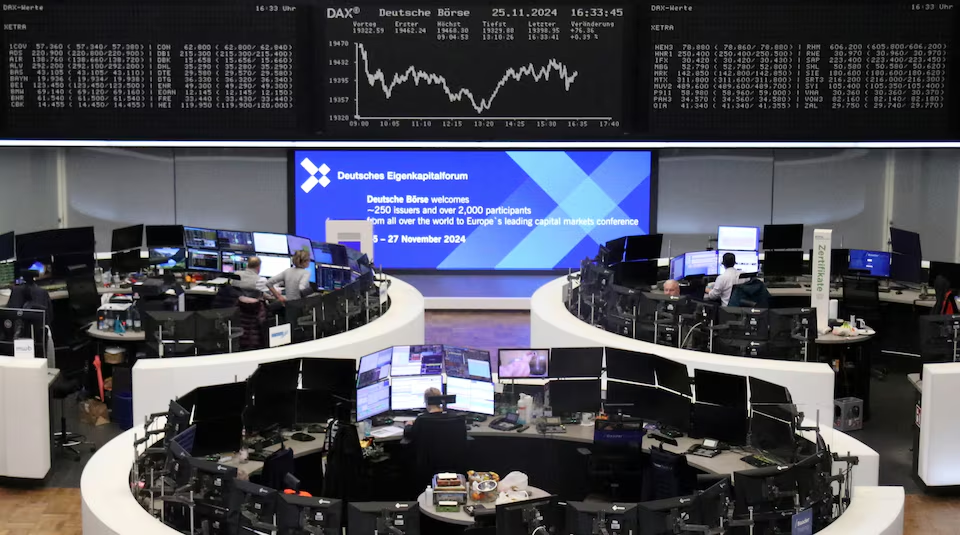Bitcoin Price Dip Fails to Squeeze Leverage as $92.5K Becomes ‘Pivotal’

Bitcoin (BTC) has long been a volatile asset, with frequent price fluctuations sparking both excitement and concern among investors. Recently, Bitcoin experienced a price dip, raising concerns about the potential for a squeeze on leveraged positions.
However, despite the decline, the anticipated squeeze has failed to materialize, with the $92.5K price level becoming a pivotal point for the cryptocurrency’s price action in the near term.
This development has left analysts and traders debating whether Bitcoin’s bullish trend will continue or if further challenges lie ahead.
Bitcoin’s Price Dip and the Leverage Squeeze
Bitcoin’s recent price dip, which saw it fall from its previous highs, triggered concerns among leveraged traders who had bet on the continued upward movement of the cryptocurrency.
Leveraged trading, where traders borrow funds to amplify their position, can create significant pressure when markets turn against them.
A price dip typically forces these leveraged positions to unwind, causing a cascade of liquidations that can exacerbate price drops.
Historically, Bitcoin has seen significant sell-offs after such leverage-driven squeezes, where forced liquidations further push prices lower. However, despite the recent dip, the much-anticipated squeeze has not occurred at the scale many had expected.
This has led to a sense of cautious optimism among some Bitcoin bulls, who believe the dip may not be the start of a more significant correction but rather a temporary pullback.
While leverage continues to be a concern, Bitcoin’s resilience in the face of this price dip suggests that market conditions may not be as precarious as initially feared.
The market seems to have absorbed the dip without triggering the broader liquidations that typically accompany such downturns.
This phenomenon has led analysts to conclude that the market might be in a stronger position than many initially believed, despite the volatility.
The Role of the $92.5K Price Level
The $92.5K price level has emerged as a critical threshold for Bitcoin as it continues to recover from its recent dip. This price point has become a psychological barrier for investors, with many seeing it as a key indicator of Bitcoin’s future price action.
If Bitcoin manages to stay above this level or quickly regain it, it could signal a return to bullish momentum, reinforcing the idea that the dip was merely a healthy correction rather than the beginning of a bearish trend.
The $92.5K level is seen by many as pivotal for multiple reasons. First, it marks a key technical support level for Bitcoin, where previous price action has shown that buyers have consistently stepped in to absorb downward pressure.
Should Bitcoin fail to hold above this level, it could indicate that the bullish trend is losing steam, with more significant downward pressure on the horizon.
However, if the price manages to reclaim and hold above $92.5K, it could signal that the dip was simply a short-term pullback and not a long-term reversal.
In addition to its technical importance, the $92.5K level also represents a psychological barrier for investors. Bitcoin has gained significant attention from both retail and institutional investors, and breaking through this level would likely trigger further buying interest, potentially pushing the price even higher.
Conversely, if Bitcoin fails to hold above $92.5K, it could lead to a wave of uncertainty among traders, prompting them to reassess their positions.
Market Sentiment and Institutional Influence
While the leverage squeeze has not yet materialized, Bitcoin’s price action remains heavily influenced by market sentiment, which can change rapidly.
The recent dip and subsequent stabilization may suggest that institutional investors continue to view Bitcoin favorably as an alternative asset.
Institutional involvement in the Bitcoin market has been increasing, with major financial institutions and hedge funds now holding large positions in the cryptocurrency.
The presence of institutional players has helped to stabilize Bitcoin’s price during times of volatility. Their involvement brings a level of sophistication to the market, with many institutions using advanced trading strategies to hedge their positions and mitigate risks.
This may explain why the anticipated leverage squeeze has not occurred as expected, as institutional investors have the resources to absorb large price swings and maintain stability.
Moreover, Bitcoin’s growing adoption as a store of value and hedge against inflation has bolstered its long-term prospects.
With global economic uncertainty, particularly due to inflationary pressures and potential recessions in major economies, many investors are turning to Bitcoin as a haven.
This institutional interest has helped to cushion Bitcoin’s price dip, preventing the type of liquidation-driven sell-off that might have occurred in earlier years.
The Bullish Case for Bitcoin
Despite the recent dip, many analysts remain bullish on Bitcoin’s long-term prospects. The cryptocurrency has experienced numerous price fluctuations in the past, but it has consistently shown the ability to recover and push higher over time.
Bitcoin’s limited supply, growing institutional support, and increasing recognition as a legitimate asset class all point to a positive future for the cryptocurrency.
Moreover, the fundamentals driving Bitcoin’s value are stronger than ever. With central banks around the world continuing to print money and adopt loose monetary policies, Bitcoin’s fixed supply of 21 million coins makes it an attractive hedge against currency devaluation.
As more institutional investors, including corporations, hedge funds, and even governments, recognize Bitcoin’s value as a store of wealth, the price is expected to continue its upward trajectory in the long term.
Bitcoin’s technological improvements, including the ongoing development of the Lightning Network and increasing integration with traditional financial systems, also add to its bullish case.
These innovations are designed to make Bitcoin more scalable and accessible to a broader range of users, helping to cement its role as a mainstream asset.
The Bearish Case and Potential Risks
On the flip side, several risks could derail Bitcoin’s bullish momentum. A failure to maintain above the $92.5K level could signal that the market is losing faith in the cryptocurrency, leading to a deeper correction. Additionally, regulatory scrutiny remains a significant concern for Bitcoin and other cryptocurrencies.
Governments around the world are increasingly focused on regulating digital assets, and any unfavorable regulatory actions could negatively impact Bitcoin’s price.
Furthermore, Bitcoin’s volatility remains a major factor to consider. Although the recent dip has not resulted in a major squeeze, the cryptocurrency market is still highly speculative and prone to rapid fluctuations.
Traders, especially those using leverage, can be vulnerable to sharp price movements that may lead to liquidation events.
Finally, external factors such as economic downturns, changes in investor sentiment, and competition from other digital assets could pose risks to Bitcoin’s price.
While cryptocurrency has gained significant traction, it is still a relatively young and volatile market, and unforeseen events could impact its long-term growth.
While Bitcoin’s recent price dip has raised concerns about the potential for a leveraged squeeze, the market’s resilience has prevented this from happening on a large scale.
The $92.5K price level has emerged as a crucial support point, and its behavior will likely dictate Bitcoin’s short-term price action.
Despite the volatility, Bitcoin’s long-term bullish case remains intact, driven by strong institutional interest, its role as a store of value, and its growing adoption in the global financial system.
However, the risks associated with Bitcoin’s volatility and regulatory challenges should not be underestimated, and market participants should remain vigilant in the face of potential price fluctuations.






